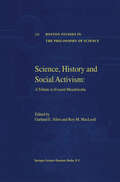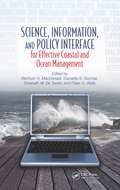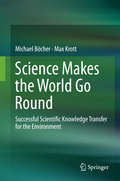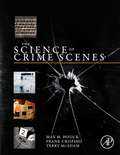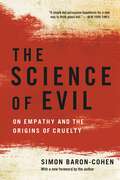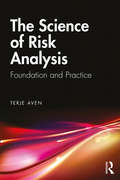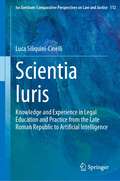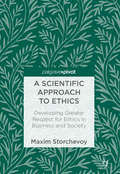- Table View
- List View
Science, History and Social Activism: A Tribute to Everett Mendelsohn (Boston Studies in the Philosophy and History of Science #228)
by Roy M. MacLeod Garland E. Allen"To earn a degree, every doctoral candidate should go out to Harvard Square, find an audience, and explain his [or her] dissertation". Everett Mendelsohn's worldly advice to successive generations of students, whether apocryphal or real, has for over forty years spoken both to the essence of his scholarship, and to the role of the scholar. Possibly no one has done more to establish the history of the life sciences as a recognized university discipline in the United States, and to inspire a critical concern for the ways in which science and technology operate as central features of Western society. This book is both an act of homage and of commemoration to Professor Mendelsohn on his 70th birthday. As befits its subject, the work it presents is original, comparative, wide-ranging, and new. Since 1960, Everett Mendelsohn has been identified with Harvard Univer sity, and with its Department of the History of Science. Those that know him as a teacher, will also know him as a scholar. In 1968, he began- and after 30 years, has just bequeathed to others - the editorship of the Journal of the History of Biology, among the earliest and one of the most important publications in its field. At the same time, he has been a pioneer in the social history and sociology of science. He has formed particularly close working relationships with colleagues in Sweden and Germany - as witnessed by his editorial presence in the Sociology of Science Yearbook.
Science in Court (Routledge Revivals)
by Michael Freeman Helen ReeceFirst published in 1998, this volume contains essays from leading thinkers on both sides of the Atlantic on the relationship between law and science. Science plays an ever-increasing part in the development of legislation and the adjudication of cases. Its limitations and its value are explored in these essays which discuss issues of methodology and of evidence. Amongst areas covered are silicone breast implants, the rape trauma syndrome, the environment, inventions and Bayesianism.
Science in Court (Routledge Revivals)
by Michael Freeman Helen ReeceFirst published in 1998, this volume contains essays from leading thinkers on both sides of the Atlantic on the relationship between law and science. Science plays an ever-increasing part in the development of legislation and the adjudication of cases. Its limitations and its value are explored in these essays which discuss issues of methodology and of evidence. Amongst areas covered are silicone breast implants, the rape trauma syndrome, the environment, inventions and Bayesianism.
Science, Information, and Policy Interface for Effective Coastal and Ocean Management
by Bertrum H. MacDonald Suzuette S. Soomai Elizabeth M. De Santo Peter G. WellsThis book provides a timely analysis of the role that information-particularly scientific information-plays in the policy-making and decision-making processes in coastal and ocean management. It includes contributions from global experts in marine environmental science, marine policy, fisheries, public policy and administration, resource management
Science Makes the World Go Round: Successful Scientific Knowledge Transfer for the Environment
by Michael Böcher Max KrottResearchers in the environmental sciences are often frustrated because actors involved with practice do not follow their advice. This is the starting point of this book, which describes a new model for scientific knowledge transfer called RIU, for Research, Integration and Utilization. This model sees the factors needed for knowledge transfer as being state-of-the-art research and the effective, practical utilization to which it leads, and it highlights the importance of “integration”, which in this context means the active bi‐directional selection of those research results that are relevant for practice. In addition, the model underscores the importance of special allies who are powerful actors that support the application of scientific research results in society. An important product of this approach is a checklist of factors for successful knowledge transfer that will be useful for scientists. By using this checklist, research projects and research programs can be optimised with regard to their potential for reaching successful knowledge transfer effects.
The Science of Crime Scenes
by Max M. Houck Frank Crispino Terry McAdamThe Science of Crime Scenes addresses the science of crime scene investigation and processing, including the latest methods and technologies. This book covers the philosophy of crime scenes as historical events, the personnel involved at a scene (including the media), the detection of criminal traces and their reconstruction, and special crime scenes, such as mass disasters and terrorist events. Written by an international trio of authors with decades of crime scene experience, it is the next generation of crime scene textbooks. The book provides in-depth coverage of disasters and mass murder, terror crime scenes, and CBRN (chemical, biological, radioactive and nuclear) – topics not covered in any other text. It includes an instructor website with lecture slides, test bank, outlines, definitions, and activities, along with a student companion site with an image collection. This text will be of interest to advanced undergraduate and graduate students in forensic science programs, as well as to forensic practitioners and crime scene technicians. Offers a science-based approach to crime scene investigationIncludes in-depth coverage of disasters and mass murder, terror crime scenes, and CBRN (chemical, biological, radioactive and nuclear) – not covered in any other textWritten by an international trio of authors with decades of crime scene experienceInstructor website with lecture slides, test bank, outlines, definitions, and activities, and a student companion site with an image collection
The Science of Crime Scenes
by Max M. Houck Frank Crispino Terry McAdamThe Science of Crime Scenes, Second Edition offers a science-based approach to crime scenes, emphasizing that understanding is more important than simply knowing. Without sacrificing technical details, the book adds significantly to the philosophy and theory of crime scene science. This new edition addresses the science behind the scenes and demonstrates the latest methods and technologies with updated figures and images. It covers the philosophy of the crime scene, the personnel involved at a scene (including the media), the detection of criminal traces and their reconstruction, and special crime scenes, such as mass disasters and terroristic events. Written by an international trio of authors with decades of crime scene experience, this book is the next generation of crime scene textbooks. This volume will serve both as a textbook for forensic programs, and as an excellent reference for forensic practitioners and crime scene technicians with science backgrounds.Includes in-depth coverage of disasters and mass murder, terror crime scenes and CBRN (Chemical, biological, radioactive and nuclear) – topics not covered in any other textIncludes an instructor site with lecture slides, images and links to resources for teaching and training
The Science of Evil: On Empathy and the Origins of Cruelty
by Simon Baron-CohenA groundbreaking and challenging examination of the social, cognitive, neurological, and biological roots of psychopathy, cruelty, and evilBorderline personality disorder, autism, narcissism, psychosis: All of these syndromes have one thing in common--lack of empathy. In some cases, this absence can be dangerous, but in others it can simply mean a different way of seeing the world.In The Science of Evil Simon Baron-Cohen, an award-winning British researcher who has investigated psychology and autism for decades, develops a new brain-based theory of human cruelty. A true psychologist, however, he examines social and environmental factors that can erode empathy, including neglect and abuse.Based largely on Baron-Cohen's own research, The Science of Evil will change the way we understand and treat human cruelty.
The Science of Right in Leibniz's Moral and Political Philosophy (Bloomsbury Studies in Philosophy)
by Christopher JohnsStudies of Gottfried Leibniz's moral and political philosophy typically focus on metaphysical perfection, happiness, or love. In this new reading of Leibniz, Christopher Johns shows that it is based on a 'science of right'. Based on the deontic concepts of jus (right) and obligation, this science of right is established in Leibniz's early writings on jurisprudence and depended on throughout several of his major late writings. Johns shows that the moral rightness of an action is grounded in the rights and obligations derived from the agent's capacity for freedom. This new interpretation of Leibniz's moral philosophy compares Leibniz's positions with Grotius, Pufendorf, Hobbes, Locke, and Kant. Providing a comprehensive examination of Leibniz's most important writings on natural right, John's argues that Leibniz, properly understood, provides a compelling account of the grounds of morality and of political institutions-an account relevant to present philosophical debates.
The Science of Right in Leibniz's Moral and Political Philosophy (Bloomsbury Studies in Philosophy)
by Christopher JohnsStudies of Gottfried Leibniz's moral and political philosophy typically focus on metaphysical perfection, happiness, or love. In this new reading of Leibniz, Christopher Johns shows that it is based on a 'science of right'. Based on the deontic concepts of jus (right) and obligation, this science of right is established in Leibniz's early writings on jurisprudence and depended on throughout several of his major late writings. Johns shows that the moral rightness of an action is grounded in the rights and obligations derived from the agent's capacity for freedom. This new interpretation of Leibniz's moral philosophy compares Leibniz's positions with Grotius, Pufendorf, Hobbes, Locke, and Kant. Providing a comprehensive examination of Leibniz's most important writings on natural right, John's argues that Leibniz, properly understood, provides a compelling account of the grounds of morality and of political institutions-an account relevant to present philosophical debates.
The Science of Risk Analysis: Foundation and Practice
by Terje AvenThis book provides a comprehensive demonstration of risk analysis as a distinct science covering risk understanding, assessment, perception, communication, management, governance and policy. It presents and discusses the key pillars of this science, and provides guidance on how to conduct high-quality risk analysis. The Science of Risk Analysis seeks to strengthen risk analysis as a field and science by summarizing and extending current work on the topic. It presents the foundation for a distinct risk field and science based on recent research, and explains the difference between applied risk analysis (to provide risk knowledge and tackle risk problems in relation to for example medicine, engineering, business or climate change) and generic risk analysis (on concepts, theories, frameworks, approaches, principles, methods and models to understand, assess, characterise, communicate, manage and govern risk). The book clarifies and describes key risk science concepts, and builds on recent foundational work conducted by the Society for Risk Analysis in order to provide new perspectives on science and risk analysis. The topics covered are accompanied by cases and examples relating to current issues throughout. This book is essential reading for risk analysis professionals, scientists, students and practitioners, and will also be of interest to scientists and practitioners from other fields who apply risk analysis in their work.
The Science of Risk Analysis: Foundation and Practice
by Terje AvenThis book provides a comprehensive demonstration of risk analysis as a distinct science covering risk understanding, assessment, perception, communication, management, governance and policy. It presents and discusses the key pillars of this science, and provides guidance on how to conduct high-quality risk analysis. The Science of Risk Analysis seeks to strengthen risk analysis as a field and science by summarizing and extending current work on the topic. It presents the foundation for a distinct risk field and science based on recent research, and explains the difference between applied risk analysis (to provide risk knowledge and tackle risk problems in relation to for example medicine, engineering, business or climate change) and generic risk analysis (on concepts, theories, frameworks, approaches, principles, methods and models to understand, assess, characterise, communicate, manage and govern risk). The book clarifies and describes key risk science concepts, and builds on recent foundational work conducted by the Society for Risk Analysis in order to provide new perspectives on science and risk analysis. The topics covered are accompanied by cases and examples relating to current issues throughout. This book is essential reading for risk analysis professionals, scientists, students and practitioners, and will also be of interest to scientists and practitioners from other fields who apply risk analysis in their work.
Science, Politics and Morality: Scientific Uncertainty and Decision Making (Theory and Decision Library A: #17)
by RenéSchombergCurrent environmental problems and technological risks are a challenge for a new institutional arrangement of the value spheres of Science, Politics and Morality. Distinguished authors from different European countries and America provide a cross-disciplinary perspective on the problems of political decision making under the conditions of scientific uncertainty. cases from biotechnology and the environmental sciences are discussed. The papers collected for this volume address the following themes: (i) controversies about risks and political decision making; (ii) concepts of science for policy; (iii) the use of social science in the policy making process; (iv) ethical problems with developments in science and technology; (v) public and state interests in the development and control of technology.
Science, Pseudo-science, Non-sense, and Critical Thinking: Why the Differences Matter
by Gershon Ben-Shakhar Marianna BarrScience, Pseudo-science, Non-sense, and Critical Thinking shines an unforgiving light on popular and lucrative ‘miraculous’ practices that promise to offer answers during times of trouble. Throughout the book, the authors unfold the fallacies underlying these practices, as well as consumers’ need and desire to believe in them. Adopting a scientific approach, the book critically evaluates research into cold-reading practices, such as those that claim to be able to communicate with the afterlife or posess supernatural powers, before considering a range of pseudo-sciences including graphology and polygraph interrogation, exposing the pretensions of these practices in a clear and logical fashion. The book seeks to encourage critical thinking throughout, asking whether there is any scientific evidence to support these practitioners’ abilities to supply us with reliable answers, and discussing the various factors that comprise the psychological mechanism of belief. Written in a fluent and accessible style, Science, Pseudo-science, Non-sense, and Critical Thinking is aimed at interested professionals and the public at large.
Science, Pseudo-science, Non-sense, and Critical Thinking: Why the Differences Matter
by Gershon Ben-Shakhar Marianna BarrScience, Pseudo-science, Non-sense, and Critical Thinking shines an unforgiving light on popular and lucrative ‘miraculous’ practices that promise to offer answers during times of trouble. Throughout the book, the authors unfold the fallacies underlying these practices, as well as consumers’ need and desire to believe in them. Adopting a scientific approach, the book critically evaluates research into cold-reading practices, such as those that claim to be able to communicate with the afterlife or posess supernatural powers, before considering a range of pseudo-sciences including graphology and polygraph interrogation, exposing the pretensions of these practices in a clear and logical fashion. The book seeks to encourage critical thinking throughout, asking whether there is any scientific evidence to support these practitioners’ abilities to supply us with reliable answers, and discussing the various factors that comprise the psychological mechanism of belief. Written in a fluent and accessible style, Science, Pseudo-science, Non-sense, and Critical Thinking is aimed at interested professionals and the public at large.
Science, Technology and Innovation Ecosystem: An Indian and Global Perspective
by Nirmala Chongtham Kashmir Singh Radhika Trikha Mamta Bhardwaj Sukhdeep KaurScience, Technology, and Innovation (STI) are the key drivers of the economy and development of a country. The economic and social impacts of STI require a deep understanding of the STI ecosystem, which includes the interactions between actors, their technologies, and their business models. This book, "Science, Technology, and Innovation Ecosystems: A National and Global Perspective," focuses on the STI ecosystem of India in comparison to other innovation-backed global countries. It will include a study of the entire STI ecosystem, focusing on the system interconnectedness required for strengthening it. The building of interconnection within actors of the STI ecosystem is one of the paramount requirements to reinvigorate the STI ecosystem as a whole. The book will also present the crucial role of STI in bringing socio-economic development from a national and international perspective. It addresses the development of viable solutions for a sustainable future and a positive societal transformation with the help of innovative science-based approaches. This book showcases the future of science in terms of emerging frontier and strategic technologies, giving us a snapshot of future STI efforts worldwide. Emphasis is given to the policy directives and program interventions backed by evidence to revamp the STI system by addressing the societal and economic needs of the country. The book will strategically bring the concept of the relevance of the Intellectual Property (IP) ecosystem in building the country’s innovation capacity along with specific pieces of evidence on how the IP system should be roped in to bring higher innovation efficiency. An insight is provided to chart out the pathway for creating a knowledge-based economy focusing on knowledge production to knowledge consumption through knowledge diffusion.
Science, Technology and Taxation (Series on International Taxation #40)
by Robert F. van BrederodeThis first comprehensive study of the interaction between technology and taxation approaches the subject along four main avenues: insight and analysis gained from empirical legal studies conducted in the area of taxation; methods for improving the control and management of the tax function in business; tax auditing through statistical sampling; and changes in the fiscal environment as a result of technological capabilities. Among the topics that arise are the following: what choices of sampling methodology exist; determination of both one-sided and two-sided confidence intervals; under what circumstances statistical sampling is acceptable as proof of underpayment and as a basis for penalties; the use of sampling agreements as a tool to improve taxpayers’ understanding of the process; complexities encountered by the introduction of technology in tax administration in developing countries; technological capability to detect economic activity in the informal sector; technological innovation as substitute for inadequate human capacity; improvements available to better monitor the movement and values of goods entering a country; safeguards to prevent unauthorized use of personal information; prioritizing resources to ensure that the key strategic objectives of the agency are being addressed; government defensive action and the threat to privacy; and capabilities and limitations of enterprise resource planning systems and tax engines. Although the author pays especially detailed attention to the technologies developed and used by the United States Internal Revenue Service, other notable systems developed by the European Union, Brazil, Mexico, and China are also examined. Various sampling methods and practices are illustrated with numerical examples. As tax systems acquire ever higher levels of integration, and because accuracy is crucial to the measurement of tax compliance, the perspectives opened and expertly analyzed by the author will prove of great importance. Practitioners, tax policymakers and administrators, tax standard setters, and tribunals dealing with disputes over tax administration and procedure, as well as academics and researchers, will instantly recognize the book’s great importance and practical value.
Science, Technology and Taxation (Series on International Taxation #40)
by Robert F. van BrederodeThis first comprehensive study of the interaction between technology and taxation approaches the subject along four main avenues: insight and analysis gained from empirical legal studies conducted in the area of taxation; methods for improving the control and management of the tax function in business; tax auditing through statistical sampling; and changes in the fiscal environment as a result of technological capabilities. Among the topics that arise are the following: what choices of sampling methodology exist; determination of both one-sided and two-sided confidence intervals; under what circumstances statistical sampling is acceptable as proof of underpayment and as a basis for penalties; the use of sampling agreements as a tool to improve taxpayers’ understanding of the process; complexities encountered by the introduction of technology in tax administration in developing countries; technological capability to detect economic activity in the informal sector; technological innovation as substitute for inadequate human capacity; improvements available to better monitor the movement and values of goods entering a country; safeguards to prevent unauthorized use of personal information; prioritizing resources to ensure that the key strategic objectives of the agency are being addressed; government defensive action and the threat to privacy; and capabilities and limitations of enterprise resource planning systems and tax engines. Although the author pays especially detailed attention to the technologies developed and used by the United States Internal Revenue Service, other notable systems developed by the European Union, Brazil, Mexico, and China are also examined. Various sampling methods and practices are illustrated with numerical examples. As tax systems acquire ever higher levels of integration, and because accuracy is crucial to the measurement of tax compliance, the perspectives opened and expertly analyzed by the author will prove of great importance. Practitioners, tax policymakers and administrators, tax standard setters, and tribunals dealing with disputes over tax administration and procedure, as well as academics and researchers, will instantly recognize the book’s great importance and practical value.
Science, Technology, and the Art of Medicine: European-American Dialogues (Philosophy and Medicine #44)
by Mary Ann GardellCutter CorinnaDelkeskamp-HayesScience, Technology, and the Art of Medicine contains papers by eminent scholars who discuss issues and concepts regarding the character of medicine. Special attention is given to the extent to which medicine is a science, art, and technology. Investigations are carried out with a particular focus on the nature of medical knowledge. Concepts of medical research, medical causality, intuition, and medical decision-making are examined in the light of medicine's revolutionary advances in the twentieth century. Past perspectives and present perplexities are also examined, bringing together a volume in the philosophy of medicine that treats a broad range of issues in medical epistemology and practise in a careful, critical fashion.
Scientia Iuris: Knowledge and Experience in Legal Education and Practice from the Late Roman Republic to Artificial Intelligence (Ius Gentium: Comparative Perspectives on Law and Justice #112)
by Luca Siliquini-CinelliLaw’s regulatory reach has grown significantly over the past few decades. Yet, at the same time, law schools and legal professions in Western and Western-oriented jurisdictions have undergone an acute crisis. How is this possible? In this insightful and wide-ranging book, Luca Siliquini-Cinelli argues that these trends are in fact complementary manifestations of a single phenomenon—namely, that law is and will always be more capable of regulating social interaction without the experiential contribution of legal experts. Siliquini-Cinelli contends that the separation of law’s regulatory function from legal experts is structurally linked to the former’s nature and operational dynamics as an intellectual artifact to be used for ordering purposes. As a product of the intellect, law is a matter of knowledge, not experience. In fact, Siliquini-Cinelli holds, law’s artifactuality voids experience, including that of legal experts, making it redundant. This explains how law can thrive as a regulatory phenomenon while the very places where future legal professionals are formed and those places where it is practised are in crisis. To show this, Siliquini-Cinelli embarks upon a historical, philosophical, and comparative analysis of law’s artifactuality, focusing on the teaching, study and practise of law as intellectual endeavours, from the advent of juristic activities in the Late Roman Republic to current legal pedagogies, practices, and reforms in Civil and Common law jurisdictions. In so doing, Siliquini-Cinelli employs the Latin phrase ‘scientia iuris’ to explain why and how legal education and practice pursue knowledge at the expense of experience, and the serious implications this has for lawyering activities. Moving beyond established narratives, Siliquini-Cinelli argues that ‘scientia iuris’ ought not be reduced to dogmatic analysis (scientia iuris as doctrina iuris). Rather, ‘scientia iuris’ denotes the knowledge of the law sought by all those who teach, study, and practise it, and which is actualised through a form of legal thinking and argumentation that moves along reason’s metaphysical, constructivist lines (scientia iuris as cognitio iuris). Thus, scientia iuris is not the prerogative of a few legal scholars; rather, it lies at the very core of Western legal education and practice, broadly understood. The relevance of Siliquini-Cinelli’s original and interdisciplinary analysis is profound and far-reaching: the crisis that legal education and practice are undergoing is not an isolated, or accidental, event; it is a consequence of the very ways in which law has been taught, studied, and practised since Rome. Endorsements ‘This richly researched book on the history of scientia iuris is a work on epistemology which argues that the legal model is highly problematic and will eventually be able to function without the intervention of jurists and lawyers. Such a thesis is based upon a very detailed knowledge both of philosophy and of the legal primary and secondary sources from Roman to modern times. The author is at home with Ancient Greek, Latin, French, German and Italian texts and this means that the research basis for the thesis not only is unusually profound – encompassing both the civil and the common law – but will make a major contribution to historical jurisprudence, to comparative legal history, to comparative law in general and to legal theory. This is legal scholarship of the highest order.’ Geoffrey Samuel, Emeritus Professor of Law, Kent Law School ‘In this exceptionally robust and expertly-researched new book, Luca Siliquini-Cinelli presents a provocative thesis. He proposes that the experience of legal experts is redundant when it comes to the success of law as a regulatory framework. Oscillating between historical, material, philosophical and literary frames, Siliquini-Cinelli introduces what he terms ‘law’s artifactuality’. Law’s artifac
Scientific and Legal Applications of Bloodstain Pattern Interpretation
by Stuart H. JamesSince 1955 when Dr. Paul Kirk first presented a bloodstain evidence affidavit in State of Ohio v. Samuel Sheppard, expert testimony on bloodstain interpretation has gained wide acceptance in U.S. courts. Scientific and Legal Applications of Bloodstain Pattern Interpretation brings together some of the most respected and noted experts in forensic science, the law, and bloodstain interpretation to provide a comprehensive overview of the discipline. It discusses research, applications, and the current view of bloodstain pattern interpretation within the legal system at the trial and appellate court levels, as well as scientific approaches and developments in the field.Scientific and Legal Applications of Bloodstain Pattern Interpretation will help attorneys who are questioning and cross-examining expert witnesses have a good working knowledge of bloodstain interpretation. Included is a full-color atlas of bloodstains, in conjunction with a glossary of terms and an outline of basic laboratory experiments that are commonly used in the discipline. Among the outstanding contributions in this volume you will find:An excellent chapter by Carol Henderson discusses the legal and ethical aspects of bloodstain pattern evidence in detail. A post-conviction analysis by Marie Elena Saccoccio evaluates how bloodstain evidence can play a role in the appeal process. Misinterpretation and overinterpretation of bloodstain evidence can occur in our courts of law-be prepared to effectively analyze the evidence and the testimony with Scientific and Legal Applications of Bloodstain Pattern Interpretation.
Scientific and Legal Applications of Bloodstain Pattern Interpretation
by Stuart H. JamesSince 1955 when Dr. Paul Kirk first presented a bloodstain evidence affidavit in State of Ohio v. Samuel Sheppard, expert testimony on bloodstain interpretation has gained wide acceptance in U.S. courts. Scientific and Legal Applications of Bloodstain Pattern Interpretation brings together some of the most respected and noted experts in forensic science, the law, and bloodstain interpretation to provide a comprehensive overview of the discipline. It discusses research, applications, and the current view of bloodstain pattern interpretation within the legal system at the trial and appellate court levels, as well as scientific approaches and developments in the field.Scientific and Legal Applications of Bloodstain Pattern Interpretation will help attorneys who are questioning and cross-examining expert witnesses have a good working knowledge of bloodstain interpretation. Included is a full-color atlas of bloodstains, in conjunction with a glossary of terms and an outline of basic laboratory experiments that are commonly used in the discipline. Among the outstanding contributions in this volume you will find:An excellent chapter by Carol Henderson discusses the legal and ethical aspects of bloodstain pattern evidence in detail. A post-conviction analysis by Marie Elena Saccoccio evaluates how bloodstain evidence can play a role in the appeal process. Misinterpretation and overinterpretation of bloodstain evidence can occur in our courts of law-be prepared to effectively analyze the evidence and the testimony with Scientific and Legal Applications of Bloodstain Pattern Interpretation.
Scientific and Technical Means of Distinguishing Between Natural and Other Outbreaks of Disease (NATO Science Partnership Subseries: 1 #35)
by BohumirKriz GrahamPearson MalcolmDandoThere is increasing concern over the possible use of biological weapons. If they are used, an attack will manifest as a disease outbreak among humans, animals or plants. It is thus important to be able to distinguish between natural disease outbreaks and the result of such an attack. The bok discusses the scientific and technical means available to investigate this question and then goes on to consider the agents of concern. The book concludes with a look forward to future developments.
A Scientific Approach to Ethics: Developing Greater Respect for Ethics in Business and Society
by Maxim StorchevoyThis book suggests that normative ethics should be developed as a social science, and that this will improve its reputation in business and society. Storchevoy defines four criteria of a good scientific method (clear definitions, correct logic, empirical verification, accurate measurement) and demonstrates how normative ethics can make use of them. He provides a historical review of the methodological evolution of normative ethics and outlines how it was moving in a nonlinear way towards this scientific development by the 16th century. A Scientific Approach to Ethics challenges the reputation of ethics among many within business and business schools as unscientific and argues that it can come to be seen as a scientific discipline able to reveal universal moral truth.
A Scientific Approach to Ethics: Developing Greater Respect for Ethics in Business and Society
by Maxim StorchevoyThis book suggests that normative ethics should be developed as a social science, and that this will improve its reputation in business and society. Storchevoy defines four criteria of a good scientific method (clear definitions, correct logic, empirical verification, accurate measurement) and demonstrates how normative ethics can make use of them. He provides a historical review of the methodological evolution of normative ethics and outlines how it was moving in a nonlinear way towards this scientific development by the 16th century. A Scientific Approach to Ethics challenges the reputation of ethics among many within business and business schools as unscientific and argues that it can come to be seen as a scientific discipline able to reveal universal moral truth.
